Construction and Optimization of the Ecological Security Pattern in Liyang, China
Abstract
:1. Introduction
2. Materials and Methods
2.1. Study Area
2.2. Data Sources and Processing
2.3. Methods
2.3.1. Granularity-Reverse Method
2.3.2. Ecosystem-Service Evaluation
2.3.3. Connectivity Evaluation
2.3.4. Construction of Ecological-Resistance Surface
2.3.5. Extraction of Ecological Corridors and Nodes
2.3.6. Network-Structure Assessment
3. Results
3.1. Ecological Sources
3.1.1. Optimal-Granularity Determination
| Granularity (m) | NP X1 | PD X2 | LPI X3 | LSI X4 | PROX_MN X5 | PLADJ X6 | CONNECT (%) X7 | COHESION (%) X8 | DIVISION X9 | SPLIT X10 | AI(%) X11 |
|---|---|---|---|---|---|---|---|---|---|---|---|
| 50 | 2400 | 6.73 | 20.51 | 60.76 | 291.63 | 83.90 | 1.86 | 98.06 | 0.91 | 11.15 | 84.13 |
| 100 | 1828 | 5.12 | 54.38 | 48.15 | 280.23 | 74.52 | 1.61 | 98.08 | 0.70 | 3.34 | 74.91 |
| 150 | 1251 | 3.51 | 55.79 | 39.26 | 154.64 | 68.75 | 1.58 | 97.59 | 0.69 | 3.18 | 69.30 |
| 200 | 865 | 2.43 | 54.33 | 33.10 | 94.41 | 64.93 | 1.58 | 96.85 | 0.70 | 3.34 | 65.62 |
| 250 | 635 | 1.77 | 56.12 | 28.97 | 67.85 | 61.67 | 1.66 | 96.48 | 0.68 | 3.13 | 62.49 |
| 300 | 474 | 1.34 | 55.32 | 25.44 | 54.35 | 59.26 | 1.62 | 95.83 | 0.69 | 3.22 | 60.23 |
| 350 | 363 | 1.02 | 56.26 | 22.50 | 41.17 | 58.22 | 1.73 | 95.52 | 0.68 | 3.11 | 59.32 |
| 400 | 257 | 0.73 | 40.32 | 20.13 | 22.28 | 56.74 | 1.81 | 93.69 | 0.80 | 5.11 | 57.99 |
| 450 | 252 | 0.72 | 52.81 | 19.07 | 26.88 | 53.57 | 1.84 | 93.89 | 0.71 | 3.50 | 54.90 |
| 500 | 195 | 0.54 | 42.26 | 17.50 | 14.10 | 53.85 | 1.80 | 92.77 | 0.79 | 4.74 | 55.31 |
| 550 | 171 | 0.47 | 57.89 | 16.16 | 19.66 | 52.56 | 1.94 | 94.44 | 0.66 | 2.94 | 54.15 |
| 600 | 144 | 0.39 | 56.80 | 15.00 | 15.27 | 52.66 | 1.98 | 93.62 | 0.67 | 3.04 | 54.38 |
| 650 | 135 | 0.38 | 55.15 | 14.54 | 14.85 | 49.23 | 1.96 | 92.91 | 0.69 | 3.22 | 51.01 |
| 700 | 102 | 0.29 | 59.07 | 13.07 | 10.86 | 50.00 | 1.75 | 93.53 | 0.64 | 2.80 | 51.99 |
| 750 | 95 | 0.27 | 60.48 | 12.38 | 11.22 | 50.48 | 2.06 | 93.33 | 0.63 | 2.68 | 52.58 |
| 800 | 96 | 0.26 | 60.95 | 12.27 | 7.92 | 48.42 | 1.91 | 93.03 | 0.62 | 2.66 | 50.55 |
| 900 | 79 | 0.22 | 43.51 | 11.10 | 4.35 | 46.92 | 1.59 | 87.84 | 0.78 | 4.57 | 49.28 |
| 1000 | 62 | 0.18 | 58.77 | 10.41 | 5.50 | 43.71 | 2.22 | 90.63 | 0.64 | 2.82 | 46.21 |
| 1100 | 60 | 0.16 | 39.35 | 9.36 | 2.58 | 45.65 | 1.19 | 85.57 | 0.81 | 5.24 | 48.46 |
| 1200 | 49 | 0.13 | 59.62 | 8.48 | 2.65 | 46.15 | 1.02 | 89.53 | 0.64 | 2.75 | 49.28 |
| Kaiser–Meyer–Olkin Measure of Sampling Adequacy | 0.746 | |
| Bartlett’s Test of Sphericity | Approx. Chi-Square | 708.871 |
| df | 55 | |
| Sig. | 0.000 | |
| Component | Eigenvalue | Variance Contribution Rate (%) | Accumulative Contribution Rate (%) |
|---|---|---|---|
| 1 | 6.329 | 57.533 | 57.533 |
| 2 | 3.249 | 29.539 | 87.073 |
| 3 | 1.101 | 10.006 | 97.078 |
| 4 | 0.230 | 2.092 | 99.170 |
| 5 | 0.075 | 0.678 | 99.849 |
| 6 | 0.008 | 0.075 | 99.924 |
| 7 | 0.007 | 0.062 | 99.986 |
| 8 | 0.001 | 0.010 | 99.996 |
| 9 | 0.000 | 0.004 | 100.000 |
| 10 | 1.240 × 10−5 | 0.000 | 100.000 |
| 11 | 6.217 × 10−6 | 5.651 × 10−5 | 100.000 |
| Variables | Factors | ||
|---|---|---|---|
| F1 | F2 | F3 | |
| NP | 0.934 | 0.318 | −0.057 |
| PD | 0.935 | 0.318 | −0.056 |
| LPI | −0.192 | −0.978 | 0.054 |
| LSI | 0.958 | 0.280 | −0.004 |
| PROX_MN | 0.935 | 0.256 | −0.073 |
| PLADJ | 0.958 | 0.259 | −0.002 |
| CONNECT | 0.000 | −0.055 | 0.992 |
| COHESION | 0.880 | −0.209 | 0.302 |
| DIVISION | 0.179 | 0.958 | −0.093 |
| SPLIT | 0.336 | 0.918 | 0.028 |
| AI | 0.957 | 0.271 | −0.020 |
3.1.2. Identification of Ecological Sources
3.2. Ecological-Resistance Surface
3.3. Ecological-Security Pattern
4. Discussion
4.1. Ecological Restoration
| Categories | Numbering in Figure 11b | Land-Use Types | Restoration Methods | |
|---|---|---|---|---|
| Barrier Points | Pinch Points | |||
| Farmland remediation | A1–A17 | 1 | Farmland | Returning farmland to woodland, grassland, or water area |
| Rural-settlement remediation | B1–B3 | 2, 4, 6, 12 | Rural construction land | Consolidating villages or settlements and improving surrounding greenery |
| Traffic optimization | C1–C5 | 3, 5, 8–11 | Road, railway | Limiting driving speed, setting warning signs, and facilitating wildlife pathways |
| Comprehensive improvement | D1–D4, D9 | Farmland, road, rural construction land | Controlling development scale, strengthening green space construction, preserving the vacant land, restoring riverbank spaces, etc. | |
| D5 | Farmland, road, railway, river, rural construction land | |||
| D6, D7 | Farmland, road, river, rural construction land, industrial and mining land | |||
| D8 | Farmland, road, railway, river, rural construction land, industrial and mining land | |||
| D10 | Farmland, rural construction land | |||
| D11 | 7 | Farmland, road, rural construction land, urban construction land, river, unused land | ||
| D12 | Urban construction land, river, unused land | |||
| D13 | Farmland, road, rural construction land, unused land | |||
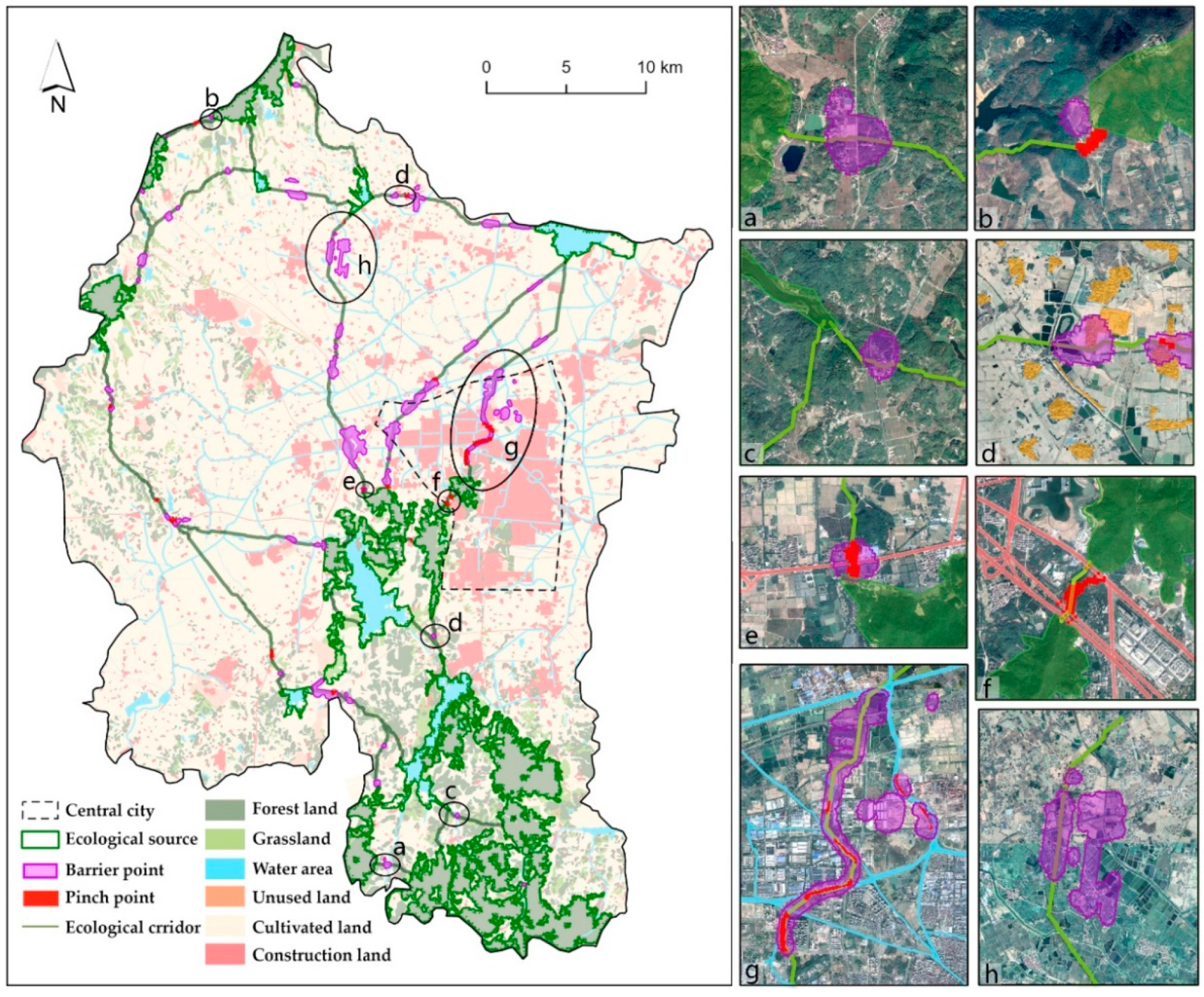
4.2. Optimization of Ecological-Security Pattern

4.3. Methodological Advantages
4.4. Limitations and Future Research Directions
5. Conclusions
Author Contributions
Funding
Data Availability Statement
Acknowledgments
Conflicts of Interest
Appendix A
| Landscape Pattern Indexes | Acronym | Formula | Explanation | |
|---|---|---|---|---|
| Composition | Number of patches | NP | The total number of patches in the landscape | |
| Patch density | PD | The number of patches within 100 hectares | ||
| Largest patch index | LPI | where is the area of patch , A is the total landscape area | The percentage of the landscape comprised by the largest patch | |
| Shape | Landscape shape index | LSI | where is the total length of edges in landscape between patch types and , A is the total landscape area | This index provides a standardized measure of total edge or edge density that adjusts for the size of the landscape. |
| Aggregation | Mean proximity index | PROX_MN | where, is the area of patch within a specified neighborhood of patch , is the distance between patch and patch , is the total number of patches | This index considers the size and proximity of all patches whose edges are within a specified search radius of the focal patch. It increases as patches become less isolated and the patch type becomes less fragmented in distribution. |
| Proportion of like adjacencies | PLADJ | where is the number of like adjacencies between pixels of patch type , is the number of adjacencies between pixels of patch types and . | This index is calculated from the adjacency matrix, which shows the frequency with which different pairs of patch types appear side-by-side on the map. It measures the degree of aggregation of the focal-patch type. | |
| Connectance index | CONNECT | where is the joining between patch is the number of patches of the corresponding patch type | This index is reported as a percentage of the maximum possible connectance given the number of patches. | |
| Patch-cohesion index | COHESION | where is the perimeter of patch in terms of number of cell surfaces, is the area of patch in terms of number of cells, is the total number of cells in the landscape | This index measures the physical connectedness of the corresponding patch type. It increases as the patch type becomes more clumped or aggregated in its distribution. | |
| Landscape-division index | DIVISION | where is the area of patch , is the total landscape area | This index is interpreted as the probability that two randomly chosen pixels in the landscape are not situated in the same patch. | |
| Splitting index | SPLIT | where is the area of patch , is the total landscape area | This index is interpreted as the effective mesh number and increases as the focal-patch type is increasingly reduced in area and subdivided into smaller patches. | |
| Aggregation index | AI | where is the number of like adjacencies between pixels of patch type , is the maximum number of like adjacencies between pixels of patch type | This index shows the frequency with which different pairs of patch types appear side-by-side on the map. It increases as the focal-patch type is increasingly aggregated. | |
References
- Ding, M.M.; Liu, W.; Xiao, L.; Zhong, F.X.; Lu, N.; Zhang, J.; Zhang, Z.H.; Xu, X.L.; Wang, K.L. Construction and optimization strategy of ecological security pattern in a rapidly urbanizing region: A case study in central-south China. Ecol. Indic. 2022, 136, 108604. [Google Scholar] [CrossRef]
- Wei, Q.Q.; Halike, A.; Yao, K.X.; Chen, L.M. Construction and optimization of ecological security pattern in Ebinur Lake Basin based on MSPA-MCR models. Ecol. Indic. 2022, 138, 108857. [Google Scholar] [CrossRef]
- Li, Y.F.; Sun, X.A.; Zhu, X.D.; Cao, H.H. An early warning method of landscape ecological security in rapid urbanizing coastal areas and its application in Xiamen, China. Ecol. Model. 2010, 221, 2251–2260. [Google Scholar] [CrossRef]
- Su, S.L.; Li, D.; Yu, X.; Zhang, Z.H.; Zhang, Q.; Xiao, R.; Zhi, J.J.; Wu, J.P. Assessing land ecological security in Shanghai (China) based on catastrophe theory. Stoch. Environ. Res. Risk Assess. 2011, 25, 737–746. [Google Scholar] [CrossRef]
- Ameen, R.F.M.; Mourshed, M. Urban sustainability assessment framework development: The ranking and weighting of sustainability indicators using analytic hierarchy process. Sust. Cities Soc. 2019, 44, 356–366. [Google Scholar] [CrossRef]
- Hodson, M.; Marvin, S. ‘Urban ecological security’: A new urban paradigm? Int. J. Urban Reg. Res. 2009, 33, 193–215. [Google Scholar] [CrossRef]
- Fu, Y.J.; Shi, X.Y.; He, J.; Yuan, Y.; Qu, L.L. Identification and optimization strategy of county ecological security pattern: A case study in the Loess Plateau, China. Ecol. Indic. 2020, 112, 106030. [Google Scholar] [CrossRef]
- Peng, J.; Zhao, H.J.; Liu, Y.X.; Wu, J.S. Research progress and prospect on regional ecological security pattern construction. Geogr. Res. 2017, 36, 407–419. [Google Scholar]
- Di Castri, F.; Hadley, M.; Damlamian, J. MAB: The Man and the Biosphere Program as an Evolving System. Ambio 1981, 10, 52–57. Available online: http://www.jstor.org/stable/4312640 (accessed on 18 September 2022).
- UNEP.org. Available online: https://www.unep.org/about-un-environment (accessed on 13 September 2022).
- Secretariat to the Convention on Biological Diversity (SCBD). Convention on Biological Diversity; United Nations: Rio de Janeiro, Brazil, 1992; Available online: https://www.cbd.int/convention/text/ (accessed on 13 September 2022).
- UN General Assembly. United Nations Framework Convention on Climate Change: Resolution/Adopted by the General Assembly. GAOR, 48th Sess. 20 January 1994. Available online: https://www.refworld.org/docid/3b00f2770.html (accessed on 13 September 2022).
- Fiorino, D.J. Explaining national environmental performance: Approaches, evidence, and implications. Policy Sci. 2011, 44, 367–389. [Google Scholar] [CrossRef]
- Andersen, M.K.; Liefferink, D. European Environmental Policy: The Pioneers, 1st ed.; Manchester University Press: Manchester, UK, 1997; pp. 40–80. [Google Scholar]
- Dearfield, K.L.; Bender, E.B.; Kravitz, M.; Wentsel, R.; Slimak, M.W.; Farland, W.H.; Gilman, P. Ecological risk assessment issues identified during the U.S. environmental protection agency’s examination of risk assessment practices. Integr. Environ. Assess. Manag. 2005, 1, 73–76. [Google Scholar] [CrossRef] [PubMed]
- Tudor, C. An Approach to Landscape Character Assessment, 1st ed.; Natural England: York, UK, 2014. [Google Scholar]
- Herlin, I.S. Exploring the national contexts and cultural ideas that preceded the Landscape Character Assessment method in England. Landsc. Res. 2016, 41, 175–185. [Google Scholar] [CrossRef]
- von Haaren, C.; Reich, M. The German way to greenways and habitat networks. Landsc. Urban Plan. 2006, 76, 7–22. [Google Scholar] [CrossRef]
- Marita, B.; Heinrich, R.; Kersten, H.; Armin, W. Habitat corridors for humans and nature in Germany. GAIA 2005, 14, 163–166. [Google Scholar] [CrossRef]
- Mackovein, P. A multi-level ecological network in the Czech Republic: Implementating the Territorial System of Ecological Stability. GeoJournal 2000, 51, 211–220. [Google Scholar] [CrossRef]
- Kubes, J. Biocentres and corridors in a cultural landscape-A critical assessment of the ‘territorial system of ecological stability. Landsc. Urban Plan. 1996, 35, 231–240. [Google Scholar] [CrossRef]
- Skokanova, H.; Slach, T. Territorial System of Ecological Stability as a regional example for Green Infrastructure planning in the Czech Republic. Landsc. Online 2020, 80, 1–13. [Google Scholar] [CrossRef]
- Yu, K.J. Security patterns and surface model in landscape ecological planning. Landsc. Urban Plan. 1996, 36, 1–17. [Google Scholar] [CrossRef]
- Fu, W.; Yu, K.J. A million mu of afforestation in Beijing plan area based on ecological security pattern. City Plan. Res. 2018, 42, 125–131. [Google Scholar]
- Li, S.; Xiao, W.; Zhao, Y.; Lv, X. Incorporating ecological risk index in the multi-process MCRE model to optimize the ecological security pattern in a semi-arid area with intensive coal mining: A case study in northern China. J. Clean. Prod. 2020, 247, 119143. [Google Scholar] [CrossRef]
- Tsou, J.Y.; Gao, Y.F.; Zhang, Y.Z.; Sun, G.Y.; Ren, J.C.; Li, Y. Evaluating urban land carrying capacity based on the ecological sensitivity analysis: A case study in Hangzhou, China. Remote Sens. 2017, 9, 529. [Google Scholar] [CrossRef]
- Su, X.P.; Zhou, Y.; Li, Q. Designing ecological security patterns based on the framework of ecological quality and ecological sensitivity: A case study of Jianghan Plain, China. Int. J. Environ. Res. 2021, 18, 8383. [Google Scholar] [CrossRef] [PubMed]
- Cui, L.; Wang, J.; Sun, L.; Lv, C.D. Construction and optimization of green space ecological networks in urban fringe areas: A case study with the urban fringe area of Tongzhou district in Beijing. J. Clean. Prod. 2020, 276, 124266. [Google Scholar] [CrossRef]
- Liu, J.L.; Li, S.P.; Fan, S.L.; Hu, Y. Identification of territorial ecological protection and restoration areas and early warning places based on ecological security pattern: A case study in Xiamen-Zhangzhou-Quanzhou Region. Acta Ecol. Sin. 2021, 41, 8124–8134. [Google Scholar]
- Wang, X.Y.; Feng, Z.; Wu, K.N.; Lin, Q. Ecological conservation and restoration of Life Community Theory based on the construction of ecological security pattern. Acta Ecol. Sin. 2019, 39, 8725–8732. [Google Scholar]
- Guo, S.; Saito, K.; Yin, W.; Su, C. Landscape Connectivity as a Tool in Green Space Evaluation and Optimization of the Haidan District, Beijing. Sustainability 2018, 10, 1979. [Google Scholar] [CrossRef]
- Lin, J.; Huang, C.; Wen, Y.; Liu, X. An assessment framework for improving protected areas based on morphological spatial pattern analysis and graph-based indicators. Ecol. Indic. 2021, 130, 108138. [Google Scholar] [CrossRef]
- Guan, D.J.; Jiang, Y.A.; Cheng, L.D. How can the landscape ecological security pattern be quantitatively optimized and effectively evaluated? An integrated analysis with the granularity inverse method and landscape indicators. Environ. Sci. Pollut. Res. 2022, 29, 41590–41616. [Google Scholar] [CrossRef]
- Lu, Y.; Sheng, J.Y.; Luo, G.G.; Chen, C.H.; Sheng, Y.C.; Li, C.Q. Landscape pattern optimization based on granularity inverse method and GIS spatial analysis. Chin. J. Ecol. 2018, 37, 534–545. [Google Scholar]
- Tan, H.Q.; Zhang, J.T.; Zhou, X.S. Construction of ecological security patterns based on minimum cumulative resistance model in Nanjing City. Bull. Soil Water Conserv. 2020, 40, 282–288, 296, 325. [Google Scholar]
- Du, T.F.; Qi, W.; Zhu, X.C.; Wang, X.; Zhang, Y.; Zhang, L. Precise identification and control method of natural resources space based on ecological security pattern in mountainous hilly area. J. Nat. Resour. 2020, 35, 1190–1200. [Google Scholar]
- Yi, L.; Sun, Y.; Yin, S.H. Construction of Ecological Security Pattern: Concept, framework and prospect. Ecol. Environ. Sci. 2022, 31, 845–856. [Google Scholar]
- Han, J.Y.; Yu, M.Y. A multi-factor integration identification method of ecological security pattern and optimization suggestions: A case study of Changshan County, Quzhou City. Geogr. Res. 2021, 40, 1078–1095. [Google Scholar]
- Yang, R.X. Optimization of Land Use Ecological Security Pattern in Yangtze River Delta under Ecological Pressure. Master Thesis, Huazhong Agricultural University, Wuhan, China, June 2021. [Google Scholar]
- Zhao, S.M.; Ma, Y.F.; Wang, J.L.; You, X.Y. Landscape pattern analysis and ecological network planning of Tianjin City. Urban For. Urban Green. 2019, 46, 126479. [Google Scholar] [CrossRef]
- Dong, J.Q.; Peng, J.; Xu, Z.H.; Liu, Y.X.; Wang, X.Y.; Li, B. Integrating regional and interregional approaches to identify ecological security patterns. Landsc. Ecol. 2021, 36, 2151–2164. [Google Scholar] [CrossRef]
- Li, S.C.; Liu, J.L.; Zhang, C.Y.; Zhao, Z.Q. The research trends of ecosystem services and the paradigm in Geography. Acta Geogr. Sin. 2011, 66, 1618–1630. [Google Scholar]
- Su, C.; Dong, J.Q.; Ma, Z.G.; Qiao, N.; Peng, J. Identifying priority areas for ecological protection and restoration of mountains-rivers-forests-farmlands-lakes-grasslands based on ecological security patterns: A case study in Huaying Mountain, Sichuan Province. Acta Ecol. Sin. 2019, 39, 8948–8956. [Google Scholar]
- Li, H.; Zhang, T.; Cao, X.S.; Zhang, Q.Q. Establishing and optimizing the ecological security pattern in Shaanxi Province (China) for ecological restoration of land space. Forests 2022, 13, 766. [Google Scholar] [CrossRef]
- Zhang, Y.Z.; Jiang, Z.Y.; Li, Y.Y.; Yang, Z.G.; Wang, X.H.; Li, X.B. Construction and optimization of an urban ecological security pattern based on habitat quality assessment and the minimum cumulative resistance model in Shenzhen City, China. Forests 2021, 12, 847. [Google Scholar] [CrossRef]
- Romero-Calcerrada, R.; Luque, S. Habitat quality assessment using weights-of-evidence based gis modelling: The case of picoides tridactylus as species indicator of the biodiversity value of the Finnish forest. Ecol. Model. 2006, 196, 62–76. [Google Scholar] [CrossRef]
- Lin, Y.P.; Lin, W.C.; Wang, Y.C.; Lien, W.Y.; Huang, T.; Hsu, C.C.; Schmeller, D.S.; Crossman, N.D. Systematically designating conservation areas for protecting habitat quality and multiple ecosystem services. Environ. Model. Softw. 2017, 90, 126–146. [Google Scholar] [CrossRef]
- Xu, J.Y.; Fan, F.F.; Liu, Y.X.; Dong, J.Q.; Chen, J.X. Construction of ecological security patterns in nature reserves based on ecosystem services and circuit theory: A case study in Wenchuan, China. Int. J. Environ. Res. Public Health. 2019, 16, 3220. [Google Scholar] [CrossRef] [PubMed] [Green Version]
- Posner, S.; Verutes, G.; Koh, I.; Denu, D.; Ricketts, T. Global use of ecosystem service models. Ecosyst. Serv. 2016, 17, 131–141. [Google Scholar] [CrossRef]
- Sharp, R.; Douglass, J.; Wolny, S.; Arkema, K.; Bernhardt, J.; Bierbower, W.; Chaumont, N.; Denu, D.; Fisher, D.; Glowinski, K.; et al. InVEST 3.12.0.post5+ug.g36c92d2 User’s Guide. The Natural Capital Project, Stanford University, University of Minnesota, The Nature Conservancy, and World Wildlife Fund. 2020. Available online: https://invest-userguide.readthedocs.io/en/latest/index.html (accessed on 18 September 2022).
- Saura, S.; Pascual-Hortal, L. A new habitat availability index to integrate connectivity in landscape conservation planning: Comparison with existing indices and application to a case study. Landsc. Urban Plan. 2007, 83, 91–103. [Google Scholar] [CrossRef]
- Taylor, P.D.; Fahrig, L.; Henein, K.; Merriam, G. Connectivity is a vital element of landscape structure. Oikos 1993, 68, 571–573. [Google Scholar] [CrossRef]
- Saura, S.; Torne, J. Conefor Sensinode 2.2: A software package for quantifying the importance of habitat patches for landscape connectivity. Environ. Model. Softw. 2009, 24, 135–139. [Google Scholar] [CrossRef]
- Liang, Y.Y.; Zhao, Y.D. Construction and optimization of ecological network in Xi’an based on landscape analysis. Chin. J. Appl. Ecol. 2020, 31, 3767–3776. [Google Scholar]
- Qi, K.; Fan, Z.Q. Evaluation method for landscape connectivity based on graph theory: A case study of natural forests in Minqing County, Fujian Province. Acta Ecol. Sin. 2016, 36, 7580–7593. [Google Scholar]
- Keeley, A.T.H.; Beier, P.; Gagnon, J.W. Estimating landscape resistance from habitat suitability: Effects of data source and nonlinearities. Landsc. Ecol. 2016, 31, 2151–2162. [Google Scholar] [CrossRef]
- Avon, C.; Berges, L. Prioritization of habitat patches for landscape connectivity conservation differs between least-cost and resistance distances. Landsc. Ecol. 2016, 31, 1551–1565. [Google Scholar] [CrossRef]
- Gurrutxaga, M.; Lozano, P.J.; Del Barrio, G. Assessing highway permeability for the restoration of landscape connectivity between protected areas in the Basque Country, Northern Spain. Landsc. Res. 2010, 35, 529–550. [Google Scholar] [CrossRef]
- Zhang, J.X.; Cao, Y.M.; Ding, F.S.; Chang, I.S. Regional ecological security pattern construction based on ecological barriers: A case study of the Bohai Bay Terrestrial ecosystem. Sustainability 2022, 14, 5384. [Google Scholar] [CrossRef]
- Kurttila, M.; Pesonen, M.; Kangas, J.; Kajanus, M. Utilizing the analytic hierarchy process (AHP) in SWOT analysis—A hybrid method and its application to a forest certification case. For. Policy Econ. 2000, 1, 41–52. [Google Scholar] [CrossRef]
- Knaapen, J.P.; Scheffer, M.; Harms, B. Estimating habitat isolation in landscape planning. Landsc. Urban Plan. 1992, 23, 1–16. [Google Scholar] [CrossRef]
- Haggett, P.; Chorley, R.J. Network Analysis in Geography, 1st ed.; Edward Arnold: London, UK, 1969; pp. 31–48. [Google Scholar]
- Forman, R.T.T.; Godron, M. Landscape Ecology, 1st ed.; John Wiley and Sons: New York, NY, USA, 1986. [Google Scholar]
- Chen, X.P.; Chen, W.B. Construction and evaluation of ecological network in Poyang Lake Eco-economic Zone, China. Chin. J. Appl. Ecol. 2016, 27, 1611–1618. [Google Scholar]
- Cook, E.A. Landscape structure indices for assessing urban ecological networks. Landsc. Urban Plan. 2002, 58, 269–280. [Google Scholar] [CrossRef]
- Gallo, J.A.; Greene, R. Connectivity Analysis Software for Estimating Linkage Priority; Conservation Biology Institute: Corvallis, OR, USA, 2018. [Google Scholar] [CrossRef]
- Fan, Y.; Wang, H.W.; Yang, S.T.; Liu, Q.; Heng, J.Y.; Gao, Y.B. Identification of ecological protection crucial areas in Altay Prefecture based on habitat quality and ecological security pattern. Acta Ecol. Sin. 2021, 41, 7614–7626. [Google Scholar]
- McGarigal, K.; Marks, B.J. Fragstats: Spatial Pattern Analysis Program for Quantifying Landscape Structure. U.S. Department of Agriculture, Forest Service, Pacific Northwest Research Station. 1995. Available online: http://www.umass.edu/landeco/research/fragstats/fragstats.html (accessed on 13 September 2022).
- Mcgarigal, K. FRAGSTATS Help. 2015. Available online: http://www.umass.edu/landeco/research/fragstats/documents/fragstats.help.4.2.pdf (accessed on 13 September 2022).




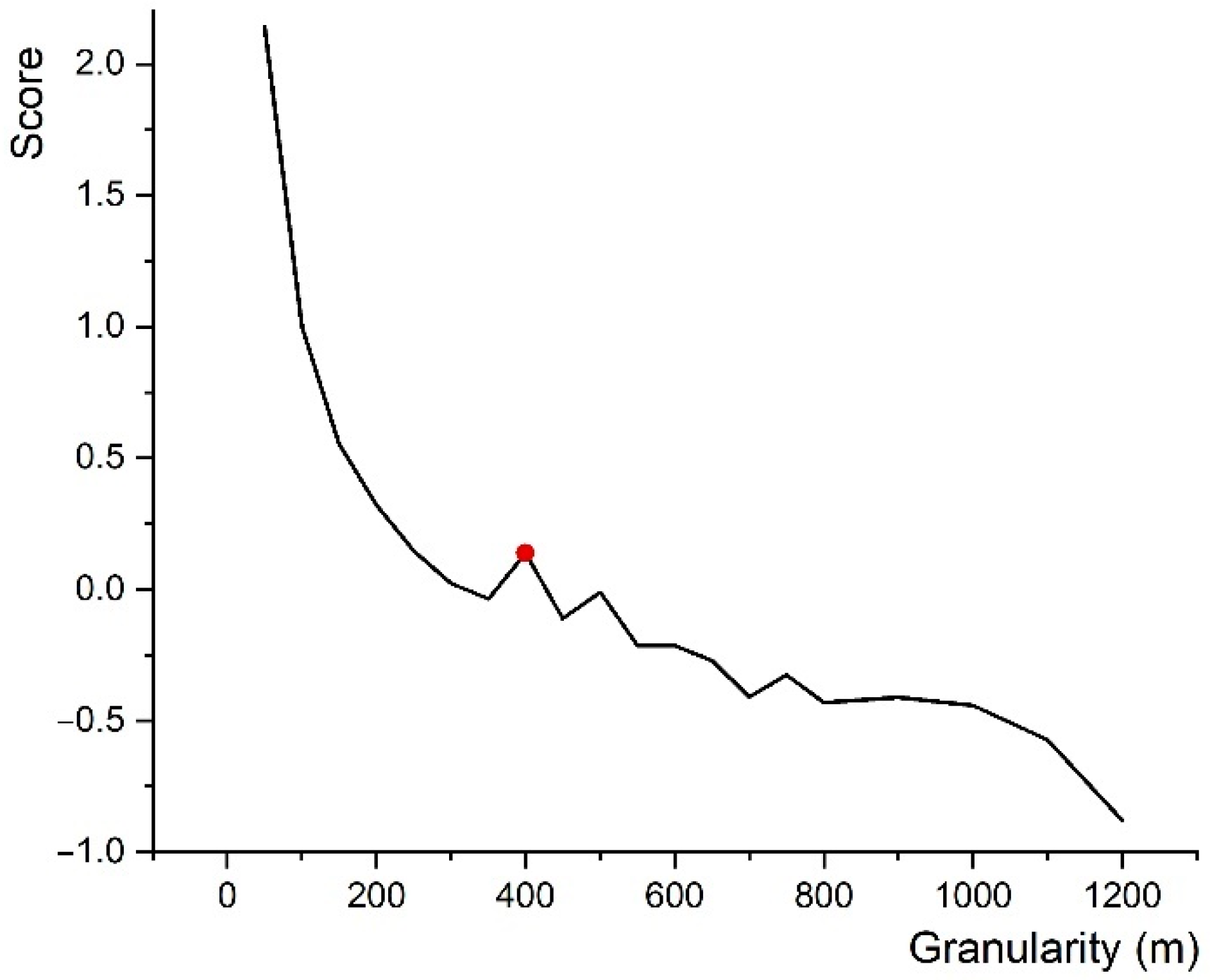
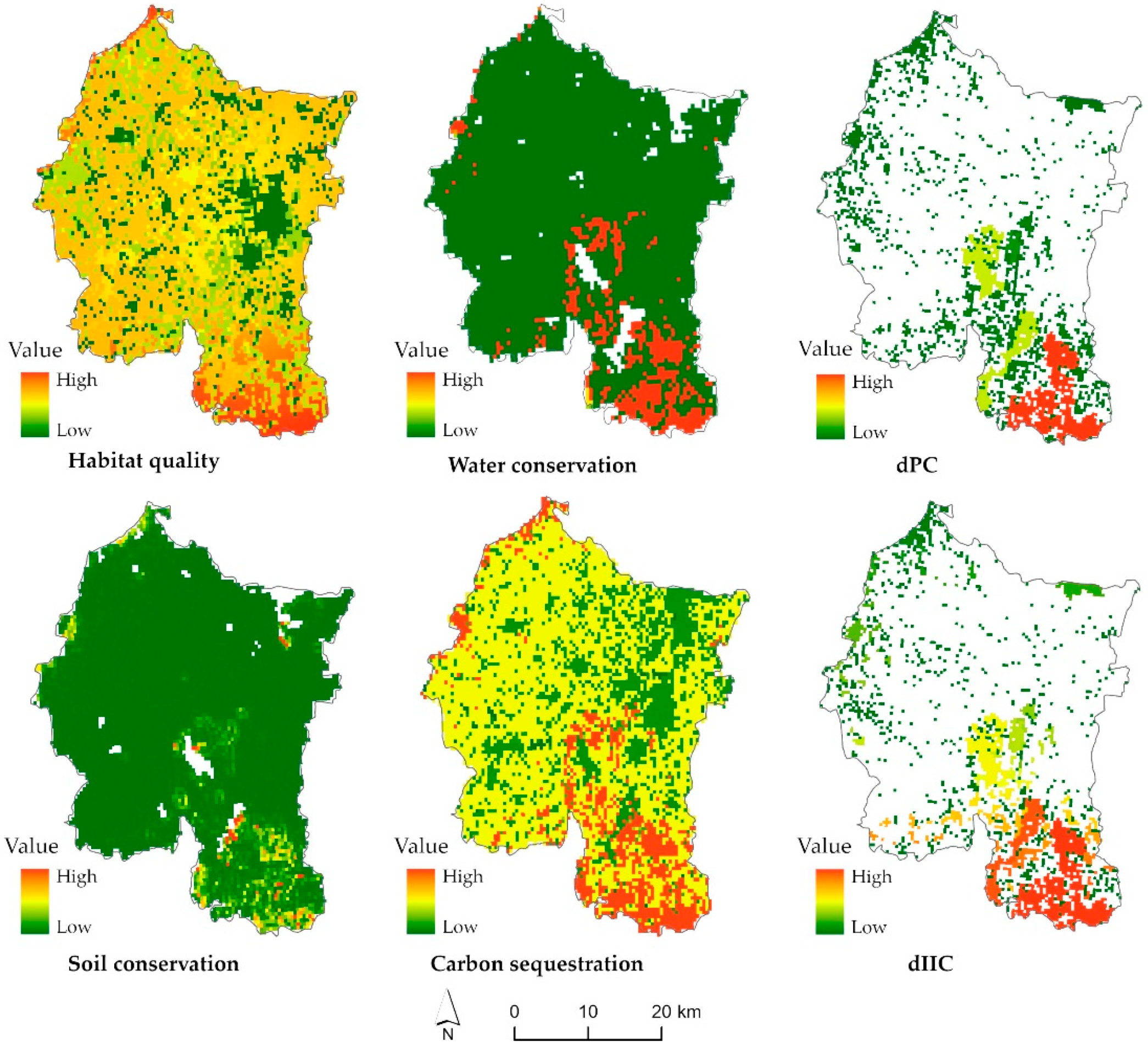

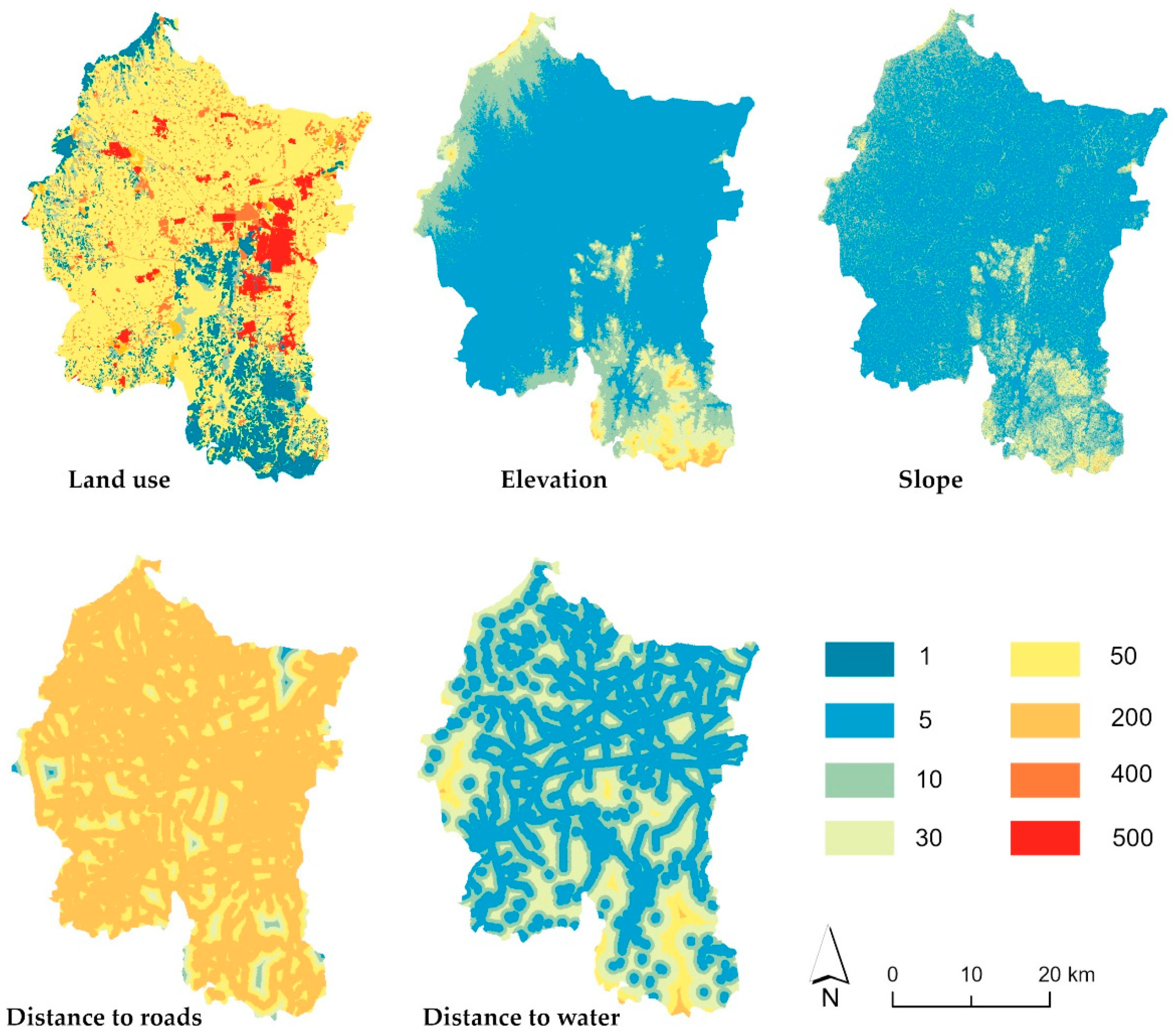

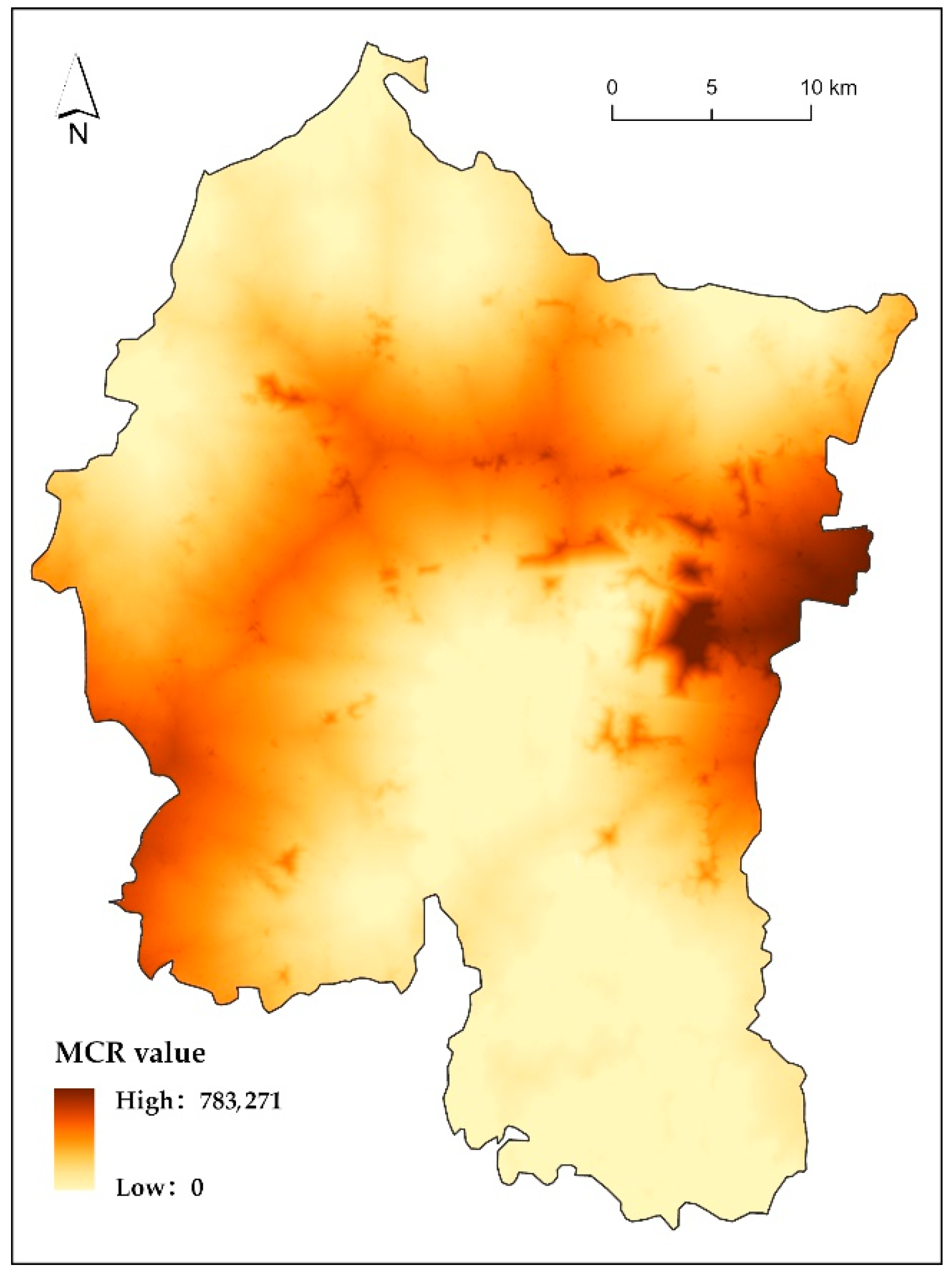



| Type | Year | Data Source | Precision | Usage |
|---|---|---|---|---|
| Remote sensing images | 2021 | USGS Landsat8 OLT_TIRS | 30 m | Identification of land-use types and ecological source; resistance-surface construction |
| DEM | 2019 | Geospatial Data Cloud ASTER GDEMV3 | 30 m | Evaluation of ecosystem services and ecological resistance |
| Meteorological data | 2020 | China Meteorological Data Service Centre | 30 m | Water-yield calculation; evaluation of soil-conservation service |
| Soil data | 2009 | FAO | 30″ | Evaluation of soil-conservation service |
| 2017 | European Soil Data Center | 30″ | ||
| Vector data (water system, transportation, etc.) | 2020 | OpenStreetMap | Water-yield calculation; evaluation of soil-conservation service |
| Index | Method | Calculation Formula | Explanation |
|---|---|---|---|
| Habitat quality | InVEST Habitat Quality Model | is the habitat quality of raster in land-use type ; is the habitat suitability of land-use type is the degree of habitat degradation of grid in land-use type ; is a half-saturation constant, typically assigned a value of 0.5; is a scaling parameter and is 2.5 in this paper. | |
| Soil conservation | InVEST SDR(Seddiment Delivery Ratio) Model | is the amount of soil conservation; is the amount of sediment retention; , and are rainfall erosivity, soil erodibility, and slope length-gradient factor in grid , respectively; and are a cover-management factor and a support practice factor in grid , respectively. | |
| Water conservation | Obtain water yield by InVEST Annual Water Yield Model and complete the calculation with the listed formula | is the amount of water conservation; is the velocity coefficient; is the topographic index; is the saturated hydraulic conductivity; is the water yield in grid . | |
| Carbon sequestration | InVEST Carbon Storage and Sequestration Model | The amount of carbon stored and sequestered is estimated according to land-use types from aboveground biomass, belowground biomass, and soil. In the formula refers to a certain land-use type, including n types; means the carbon density of land use ; , and are the aboveground carbon density, belowground carbon density, and soil carbon density of land use , respectively; is the total amount of carbon storage; is the area of land use |
| Indexes | Weight | Factors | Resistance Value |
|---|---|---|---|
| Land-use type | 0.5 | Cultivated land | 50 |
| Forest land | 1 | ||
| Water area | 50 | ||
| Grassland | 10 | ||
| Urban and other construction land | 500 | ||
| Rural residential area | 400 | ||
| Unused land | 200 | ||
| Elevation (m) | 0.15 | <29 | 5 |
| 29–72 | 10 | ||
| 72–141 | 30 | ||
| 141–246 | 50 | ||
| 246–509 | 200 | ||
| Slope (°) | 0.1 | 0–5 | 5 |
| 5–15 | 10 | ||
| 15–25 | 30 | ||
| 25–35 | 50 | ||
| >35 | 200 | ||
| Distance from roads (km) | 0.1 | <0.5 | 200 |
| 0.5–1 | 100 | ||
| 1–2 | 30 | ||
| 2–3 | 10 | ||
| >3 | 5 | ||
| Distance from waterbodies (km) | 0.15 | <1 | 5 |
| 1–3 | 10 | ||
| 3–5 | 30 | ||
| 5–8 | 50 | ||
| >8 | 200 |
| Indexes | Landscape Connectivity | Network Structure | |||
|---|---|---|---|---|---|
| PC | IIC | α | β | γ | |
| Before | 0.026 | 0.013 | 0.169 | 1.281 | 0.456 |
| After | 0.032 | 0.018 | 0.254 | 1.447 | 0.509 |
Publisher’s Note: MDPI stays neutral with regard to jurisdictional claims in published maps and institutional affiliations. |
© 2022 by the authors. Licensee MDPI, Basel, Switzerland. This article is an open access article distributed under the terms and conditions of the Creative Commons Attribution (CC BY) license (https://creativecommons.org/licenses/by/4.0/).
Share and Cite
Fan, X.; Cheng, Y.; Tan, F.; Zhao, T. Construction and Optimization of the Ecological Security Pattern in Liyang, China. Land 2022, 11, 1641. https://doi.org/10.3390/land11101641
Fan X, Cheng Y, Tan F, Zhao T. Construction and Optimization of the Ecological Security Pattern in Liyang, China. Land. 2022; 11(10):1641. https://doi.org/10.3390/land11101641
Chicago/Turabian StyleFan, Xiangnan, Yuning Cheng, Fangqi Tan, and Tianyi Zhao. 2022. "Construction and Optimization of the Ecological Security Pattern in Liyang, China" Land 11, no. 10: 1641. https://doi.org/10.3390/land11101641





